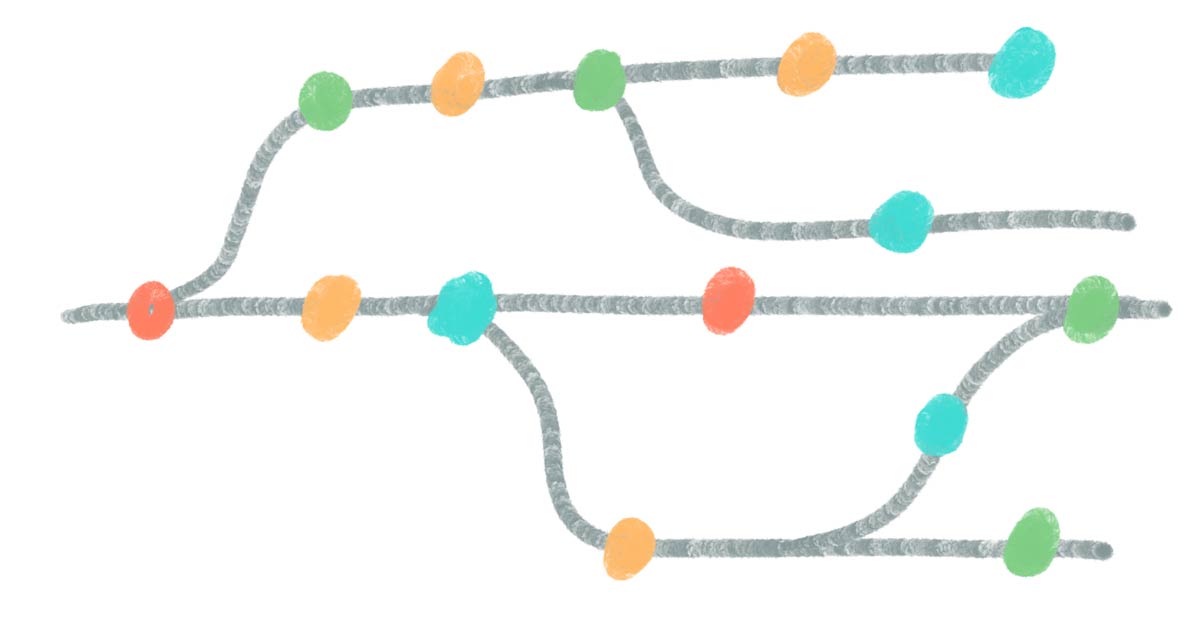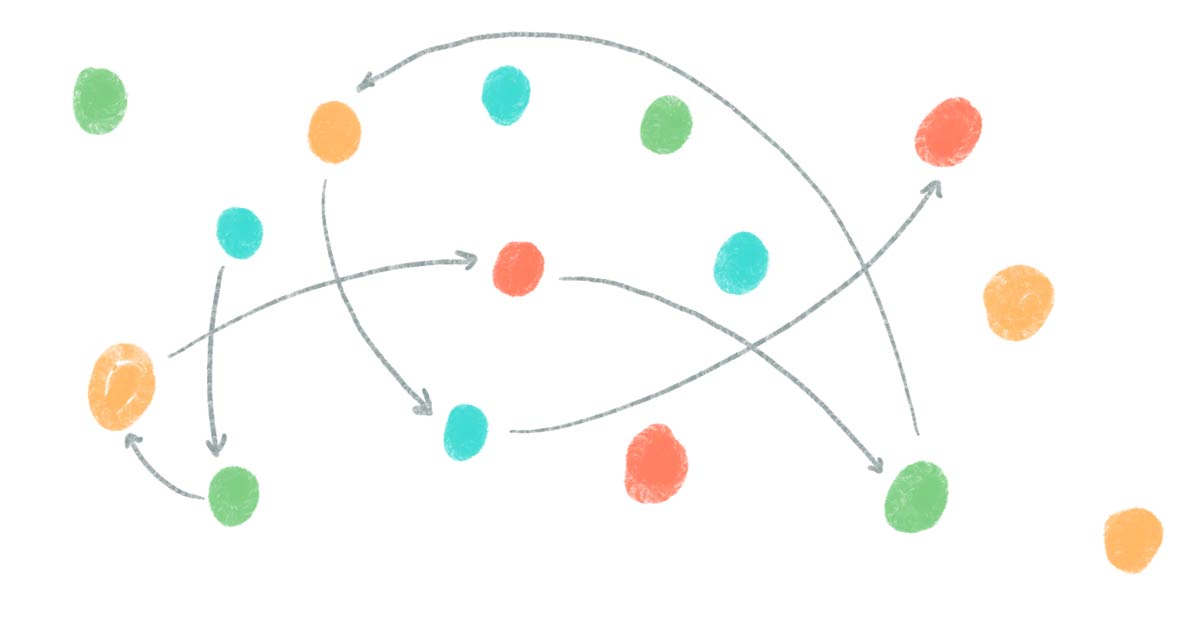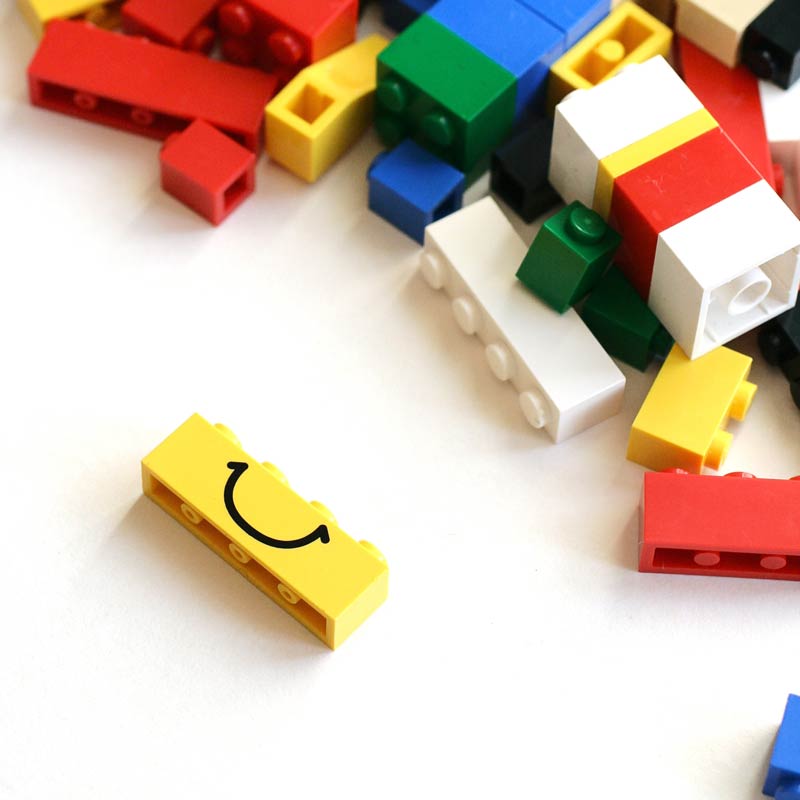What do you do when an activity takes 15 minutes but you had 45 planned for it?
Or when your client tells you that you now have two hours, but you were planning for three?
Or when you’re not able to get any information about the people who make up the group you’ll be spending a day facilitating, until you’re in the space with them?
I could tell you what I used to do, but it involved a lot of scribbling and drawing of arrows.
In all three cases, adding modularity to your facilitation is the better answer – at least a big part of it! Modularity is the difference between panicking things aren’t going how you expected and excited you get to try that thing you had in your back pocket.
Let’s take a second to get on the same page about what I mean by modularity in facilitation, then I’ll talk about some common patterns you might find handy, link you to a TED talk about making toast, and share a few easy-to-incorporate tweaks for adding modularity into your facilitator process.
What does “modularity” mean for a facilitator?
I’m not going to bust out Merriam-Webster here, because I’m not even sure I’m using this word in a way that’s technically what the word means. Here’s a definition I’m going to make up instead:
- Modularity means creating several distinct components (e.g., activities, processes, breaks, energizers) that can be linked together in a variety of ways, exist independent of one another, or be re-ordered with ease.
Modularity is one of the key design principles of Facilitator Cards. Maybe you’ve seen two of our cards and thought, “Oh yeah! I’ve done those, but together. That’s _____!” (Where the blank is the name of the activity as you’ve experienced it.) Yes, those two processes can be combined to create that activity. They can also be combined to create infinite others, or facilitated on their own, without each other, to create even more possibilities (two infinities and beyond!).
Instead of handing you a full curriculum with all the steps, processes, and sequences written up, we’re handing you a bunch of pieces, and its’ up to you to piece them together. That’s modularity.
But you don’t need to use “Facilitator Cards” to add modularity to your facilitation. (Actually, we ended up inventing Facilitator Cards by accident, as a byproduct of adding modularity to our facilitation. But that’s a story for another day.)
Modularity is as much a mindset as it is about the physical tools you have in your kit (although there are some general tools we’d recommend). And there are a few tweaks you can make to your facilitation planning & prep that will add modularity, and help you with those prickly situations I mentioned at the beginning of this post.
Setting Up Camp in the Modularity Mindset
There are three things you need to be asking yourself when you’re planning and preparing for your next training, retreat, meeting, or whatever-other-flavor-of-facilitation you’re facilitating:
1. What’s at the bottom of this, underneath all the decoration?
A habit we fall into if we’ve been facilitating for awhile is forgetting why we’re doing a particular process. We know what it does, and we have all the prompts, anecdotes, jokes, twists, gotchas, or follow-up questions in mind that we’ve used before to make it work, but we’ve become distanced from why we’re using that process to begin with.
We’ve lost touch with the first principles that drive many of our go-to facilitation processes.
Without the anecdotes you use to set it up, and the jokes you use during the instructions, and the follow-up questions you know will really crack it wide open for your group – because you’re a pro, and you know these things will work from experience – there is still something there. What is it?
To really leverage the power of modularity, we need to be able to recognize what’s at the core of the processes we’re facilitating. Because this core – the first principle that answers what it’s for – is useful without any decoration, and we’ll realize ways we can dress it up for whatever needs present themselves.
That yellow Lego brick that came in the set to build a duck isn’t just good for building ducks.
2. Is it possible to do this without that?
We often think one activity needs another in order to work, because we’ve generally done them in that order. For example, maybe you’ve always started out the day with a particular icebreaker or energizer, then moved from that into your first thing.
The modularity mindset is asking “Do I need that first icebreaker to do the other thing? Or can it stand on its own without the icebreaker?”
When planning a facilitation, regularly ask yourself, “Can I do this process without the thing I generally do that segue-ways into it? And can I do this process without segue-ing into whatever usually follows? Can it stand on its own?”
And whenever the answer is “This can stand on its own,” you’ve found yourself a module! More on this in a second. But first, one more mindset thing.
3. What are the dials I can turn? The variables I can swap in?
The final thing to focus on is the customizability of any particular facilitation process you’re facilitating.
There are some obvious dials that we all think about, like time (Can I make this shorter? Longer? WAY longer?) and group configuration (What if I did this in pairs? Individuals?). These are the universals, and they’re absolutely worth keeping in mind. They’re a big part of modularity. But they’re only part.
The secret sauce is identifying the dials that are unique to the particular process you’re facilitating. What are the knobs you can turn up or down (beyond time, group size, etc.) to really alter the core of this process?
Every process has at least something. You’ve probably heard about a ton of these dials from other facilitators, when you’re swapping stories about facilitating the same thing. “Have you ever tried it with…?” Or, “Sometimes I switch it up and…”
These variables are where fun, creative, and sometimes-hard-to-grock instructions come from, like “you can’t communicate verbally,” or “you only get 1 sticky note,” or “you have to write with your off-hand,” that, during the debrief, participants latch onto: “You having us do it that way was really powerful because…”
If you want to add modularity to your facilitation, identify the dials you can turn – or the variable aspects of the processes you’re facilitating – and be ready to start twisting.
From Modular Mindset to Facilitating Modularity
Once you start asking yourself the questions above, you’ll inevitably stumble upon some gems. You’ll realize, repeatedly:
- The core of this process is useful in a lot of different ways, distinct from the ways I’ve always used it;
- It can totally stand on its own; and
- There are several dials I can tune to refocus this process toward different outcomes, or to excel in a different context.
When you’ve got three yesses, you have a module! And a module is a necessary building block for modular facilitation (surprising literally nobody). If we want to get technical, you don’t need a module; you need modules. And more = better.
Planning with Modules in Mind: 2 Common Patterns
Maybe you used to (or still currently do) plan how I used to plan facilitations: creating outlines and agendas. This is what I’ll call “linear” facilitation planning. We have a line, and every step, activity, break, etc. is placed somewhere on that line after the process before it, and before the process after it.
For modular facilitation, need to move beyond linear planning.
Multi-Linear Modularity
One way you can add modularity to your planning is simply to introduce more lines. You can think of this like on and off ramps from a major highway. At a particular point, you might decide “we’ll detour off the highway if…” and write up your alternative line of processes there, knowing you can merge back onto the highway when you’re done with that excursion, or continue down a different road altogether.

Adding detours, or multi-linear planning, is a go-to modularity pattern when:
- There are a lot of things you have to get to. It’s out of your hands. But you still want to be able to respond to things that come up in the room. Plan detours for addressing those things that come up, if they do.
- You and/or your co-facilitator needs the psychological safety of having everything mapped out.
- You have a lot of experience facilitating this stuff with people like this, so you’re confident you know what they will end up needing.
Non-Linear Modularity
Another way to add modularity is to get rid of lines altogether, and focus instead on dots. You can think of this like lily pads, and you and your group being the frog jumping between them. Maybe you go from the one on the left to the one on the right,but you could also start on the right and go left. Or you leap over both of those onto a third one instead, then realize you need to jump back to the one on the right. It all depends on what makes the most sense from the lily pad you’re standing on.

Creating lily pads, or non-linear planning, is a go-to modularity pattern when:
- There are tons of things you could get to, and it’s hard to decide which one is the most important. But what is clear is that it’s important that whatever you get to is time well spent.
- You and/or your co-facilitator enjoys the adventure of finding the correct path by walking it.
- You don’t have a lot of experience facilitating this stuff with people like this, so you need to create situations where they can teach you what they need, and you can deliver that.
There are plenty of other patterns you can experiment with if you want to add modularity to your facilitation, but we’ll move forward with just these two in mind for now.
Let’s talk about how we put these patterns into play.
Making Sense of Modules on Paper
Maybe you’re wondering “But how does one feasibly plan either of the above? How do you write up a multi-linear agenda? Or what goes on paper if you’re going non-linear? Where does one procure lily pads? Do I need to water them?!”
Hooray! Great! You’re at the right point in this linear blog post. If you’re not wondering those things, I suggest you either (A) Return to the “What does modularity mean for a facilitator?” heading above; or (B) Jump to a different blog post (this one probably isn’t for you).
To flourish with modular facilitation planning, you need to be able to physically move things around. This isn’t required (I’ve been as guilty as anyone of scribbling things out and drawing arrows all over my agenda to “move” paragraphs), but it’s super, super preferable.
So, how can we make agendas that are easy to move around? My favorite way: create agendas with index cards!
Write a process you’re planning, whether it’s a detour from your main agenda highway or a lily pad you might be jumping to, on an individual index card. And only that process! That’s Rule #1 for modular facilitation planning: only one module per piece of paper (or whatever moveable thing you’re writing on).
On the front, I tend to write a title or quick description, as well as timing and group configuration info. Just enough to jog my memory in the moment of when I’m considering that module against another. Then, on the back, I write a longer description and other details (e.g., the framing, prompts, questions, step-by-steps). Different highlighters or colored markers are also clutch for helping you quickly make decisions or notice differences between two index cards. (The astute reader might be noticing that this paragraph is basically describing makeshift Facilitator Cards – that’s no coincidence.)
But if you’re more of a type things up and print them person, you can make that work, too. Just use a lot of page breaks, and make it easy to re-order your agenda on the fly (don’t staple the whole thing together – paper clips are your friend!).
For Planning vs. For Prep vs. In the Moment
I haven’t teased out planning, prep, and in-the-moment modularity yet. I’ve presented all three above, at different times. And that’s because modularity is useful for facilitators in all three of those situations.
And it’s not a take it all or leave it thing: you can benefit from modularity in just your planning, or just for planning & prep – even if you don’t go full leap frog with your group.
Modular Planning
For just planning, modularity will help you come up with the most creative, covering-all-the-angles, no-stone-left-unturned facilitation agenda possible. And I’m not just blowing wind in your sails here. There’s a TED talk that explains everything I’d explain here better, and it’s a TED talk. Go watch “Got a wicked problem? First, tell me how you make toast” and let Tom Wujec explain how great modularity is for facilitation planning.
Use both of the modular patterns above as you’re figuring out your agenda. You might start with a non-linear, full leap frog approach as you and your co-facilitator narrow things down. Then move on to a few different multi-linear, detour-friendly options.
Write up all your individual processes, activities, breaks, etc. on index cards, then arrange them into a row. Then re-arrange them. Then create a new module and put it in there. How does that improve things? Mess things up? What else might you need to add? Can you take that other module away now?
Once you’re happy with the order, and feel like you’ve thought of everything, you can translate the flow of index cards into a typed-up linear agenda. Easy-peasy.
Modular Prep
For just prep, modularity helps you make sure you’re ready for everything you have planned for your group. If you have all of the steps of your facilitation on index cards, you can run through them like flash cards. Focusing only on the areas where you’re still shaky, or unsure, and dividing the facilitation easily between you and your co-facilitator(s).
Denote who is facilitating what at the top of each index card. Write out what your role will be, or how you plan to transition from the last thing to this one. Create “just in case” cards, or contingencies in case unexpected things happen. What if it rains? What if the lunch catering is late? Early?
If you did modular planning, you’ll already have the cards made. Just hang on to them for prep. If not, you can easily translate a written agenda into a bunch of cards for prep. Again: think flash cards.
Modular In-the-Moment
For in-the-moment facilitation, modularity helps you be ready for, and respond to, everything that surfaces from your participants. Where a linear agenda limits the possible paths forward, a fully-modular approach is entirely open-ended. Creating a bunch of modules, and knowing the dials you can use to tweak them, will set you up to facilitate an experience that is truly responsive.
Make sure you’re able to easily sort through the modules you have at your disposal (why index cards are so great Reason #709). Be comfy enough with every module you might go to that all you need is a few key words of reminding (don’t skip the Modular Prep). Leverage break times and individual/reflective activities to plan the next module (this is especially true if you’re co-facilitating). And know that you won’t get to everything you have planned – and that’s the idea!
This might feel like the riskiest of the three (less like Leap Frog and more like Frogger – splat!), and I feel you on that. For a long time in my facilitation journey, I wouldn’t have considered going down this road. And there are still times today when I don’t see fully modular facilitation as the right approach.
But if you’re not considering modular facilitation because of fear (a fear I shared!), allow me to push back a tiny bit. We often focus so much on the mitigating the risks of something going wrong, that we ignore the risks inherent in things going right. Namely, what if everything goes to exactly to plan, but your plan wasn’t what the group needed, or what the moment demanded, or capable of seizing an opportunity that presented itself?
Modular Facilitation FTW(W)
With planning & prep, modularity makes things easier and more convenient. You’re able to iterate on ideas, come up with creative solutions, and save time reworking your agenda. I’d chalk that up as a win.
With modular agendas, you’re able to mix things up with ease, address the unexpected, get to everything in your “parking lot” that you want to get to, and tailor your facilitation to precisely meet your participants’ needs. Modular agendas make it easy to lean into fully-responsive facilitation. Another win in my book!
But my favorite thing about modular facilitation is the fact that it’s a win-win: it’s great for us, as facilitators, and it’s also great for our participants.
Whether we’re using modularity in our facilitation planning, prep, or in-the-moment, it’s something that makes our lives easier and our participant’s experiences more meaningful. It’s time saved for us and quality time gained for them.
What better reason could you need for giving it a shot?
This post was originally posted at the Facilitator Cards blog. Facilitator Cards are set of processing tools for facilitators (not our participants) that help facilitators prepare, improvise, and respond better to their groups. Learn more at the Facilitator Cards website.

